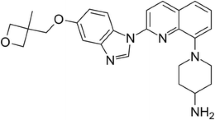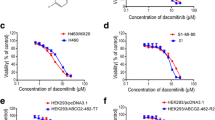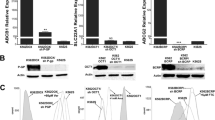Abstract
Purpose
Bortezomib is an important agent in multiple myeloma treatment, but resistance in cell lines and patients has been described. The main mechanisms of resistance described in cancer fall into one of two categories, pharmacokinetic resistance (PK), e.g. over expression of drug efflux pumps and pharmacodynamic resistance, e.g. apoptosis resistance or altered survival pathways, where the agent reaches an appropriate concentration, but this fails to propagate an appropriate cell death response. Of the known pump mechanisms, P-glycoprotein (P-gp) is the best studied and considered to be the most important in contributing to general PK drug resistance. Resistance to bortezomib is multifactorial and there are conflicting indications that cellular overexpression of P-gp may contribute to resistance agent. Hence, better characterization of the interactions of this drug with classical resistance mechanisms should identify improved treatment applications.
Methods
Cell lines with different P-gp expression levels were used to determine the relationship between bortezomib and P-gp. Coculture system with stromal cells was used to determine the effect of the local microenvironment on the bortezomib–elacridar combination. To further assess P-gp function, intracellular accumulation of P-gp probe rhodamine-123 was utilised.
Results
In the present study, we show that bortezomib is a substrate for P-gp, but not for the other drug efflux transporters. Bortezomib activity is affected by P-gp expression and conversely, the expression of P-gp affect bortezomib’s ability to act as a P-gp substrate. The local microenvironment did not alter the cellular response to bortezomib. We also demonstrate that bortezomib directly affects the expression and function of P-gp.
Conclusions
Our findings strongly support a role for P-gp in bortezomib resistance and, therefore, suggest that combination of a P-gp inhibitor and bortezomib in P-gp positive myeloma would be a reasonable treatment combination to extend efficacy of this important drug.






Similar content being viewed by others
References
Richardson PG, Mitsiades C, Schlossman R, Munshi N, Anderson K (2007) New drugs for myeloma. Oncologist 12:664–689
O’Connor R (2007) The pharmacology of cancer resistance. Anticancer Res 27:1267–1272
Yang HH, Ma MH, Vescio RA, Berenson JR (2003) Overcoming drug resistance in multiple myeloma: the emergence of therapeutic approaches to induce apoptosis. J Clin Oncol 21:4239–4247
Grogan TM, Spier CM, Salmon SE et al (1993) P-glycoprotein expression in human plasma cell myeloma: correlation with prior chemotherapy. Blood 81:490–495
Sonneveld P, Suciu S, Weijermans P et al (2001) Cyclosporin A combined with vincristine, doxorubicin and dexamethasone (VAD) compared with VAD alone in patients with advanced refractory multiple myeloma: an EORTC–HOVON randomized phase III study (06914). Br J Haematol 115:895–902
Dalton WS, Crowley JJ, Salmon SS et al (1995) A phase III randomized study of oral verapamil as a chemosensitizer to reverse drug resistance in patients with refractory myeloma. A Southwest Oncology Group study. Cancer 75:815–820
Friedenberg WR, Rue M, Blood EA et al (2006) Phase III study of PSC-833 (valspodar) in combination with vincristine, doxorubicin, and dexamethasone (valspodar/VAD) versus VAD alone in patients with recurring or refractory multiple myeloma (E1A95): a trial of the Eastern Cooperative Oncology Group. Cancer 106:830–838
Sonneveld P, Marie JP, Huisman C et al (1996) Reversal of multidrug resistance by SDZ PSC 833, combined with VAD (vincristine, doxorubicin, dexamethasone) in refractory multiple myeloma. A phase I study. Leukemia 10:1741–1750
Rumpold H, Salvador C, Wolf AM, Tilg H, Gastl G, Wolf D (2007) Knockdown of PgP resensitizes leukemic cells to proteasome inhibitors. Biochem Biophys Res Commun 361:549–554
Loo TW, Clarke DM (1999) The human multidrug resistance P-glycoprotein is inactive when its maturation is inhibited: potential for a role in cancer chemotherapy. FASEB J 13:1724–1732
Duffy CP, Elliott CJ, O’Connor RA et al (1998) Enhancement of chemotherapeutic drug toxicity to human tumour cells in vitro by a subset of non-steroidal anti-inflammatory drugs (NSAIDs). Eur J Cancer 34:1250–1259
Clynes M, Redmond A, Moran E, Gilvarry U (1992) Multiple drug-resistance in variant of a human non-small cell lung carcinoma cell line, DLKP-A. Cytotechnology 10:75–89
Murphy L, Clynes M, Keenan J (2007) Proteomic analysis to dissect mitoxantrone resistance-associated proteins in a squamous lung carcinoma. Anticancer Res 27:1277–1284
Collins DM, Crown J, O'Donovan N et al (2010) Tyrosine kinase inhibitors potentiate the cytotoxicity of MDR-substrate anticancer agents independent of growth factor receptor status in lung cancer cell lines. Invest New Drugs 28(4):433–444
Roovers DJ, van Vliet M, Bloem AC, Lokhorst HM (1999) Idarubicin overcomes P-glycoprotein-related multidrug resistance: comparison with doxorubicin and daunorubicin in human multiple myeloma cell lines. Leuk Res 23:539–548
Sarver JG, Klis WA, Byers JP, Erhardt PW (2002) Microplate screening of the differential effects of test agents on Hoechst 33342, rhodamine 123, and rhodamine 6G accumulation in breast cancer cells that overexpress P-glycoprotein. J Biomol Screen 7:29–34
Martin A, Clynes M (1991) Acid phosphatase: endpoint for in vitro toxicity tests. In Vitro Cell Dev Biol 27A:183–184
McMillin DW, Delmore J, Weisberg E et al (2010) Tumor cell-specific bioluminescence platform to identify stroma-induced changes to anticancer drug activity. Nat Med 16:483–489
McMillin DW, Ooi M, Delmore J et al (2009) Antimyeloma activity of the orally bioavailable dual phosphatidylinositol 3-kinase/mammalian target of rapamycin inhibitor NVP-BEZ235. Cancer Res 69:5835–5842
Ooi MG, Hayden PJ, Kotoula V et al (2009) Interactions of the Hdm2/p53 and proteasome pathways may enhance the antitumor activity of bortezomib. Clin Cancer Res 15(23):7153–7160
Schmidmaier R, Baumann P, Meinhardt G (2006) Cell-cell contact mediated signalling—no fear of contact. Exp Oncol 28:12–15
Chou TC, Talalay P (1983) Analysis of combined drug effects: a new look at a very old problem. Trends Pharmacol Sci 4:450–454
Chou TC, Talalay P (1984) Quantitative analysis of dose-effect relationships: the combined effects of multiple drugs or enzyme inhibitors. Adv Enzym Regul 22:27–55
Hideshima T, Mitsiades C, Tonon G, Richardson PG, Anderson KC (2007) Understanding multiple myeloma pathogenesis in the bone marrow to identify new therapeutic targets. Nat Rev Cancer 7:585–598
Nakamura T, Tanaka K, Matsunobu T et al (2007) The mechanism of cross-resistance to proteasome inhibitor bortezomib and overcoming resistance in Ewing’s family tumor cells. Int J Oncol 31:803–811
Iijima M, Momose I, Ikeda D (2010) Increased ABCB1 expression in TP-110-resistant RPMI-8226 cells. Biosci Biotechnol Biochem 74:1913–1919
Styczynski J, Olszewska-Slonina D, Kolodziej B, Napieraj M, Wysocki M (2006) Activity of bortezomib in glioblastoma. Anticancer Res 26:4499–4503
Wiberg K, Carlson K, Aleskog A, Larsson R, Nygren P, Lindhagen E (2009) In vitro activity of bortezomib in cultures of patient tumour cells—potential utility in haematological malignancies. Med Oncol 26:193–201
Fujita T, Washio K, Takabatake D et al (2005) Proteasome inhibitors can alter the signaling pathways and attenuate the P-glycoprotein-mediated multidrug resistance. Int J Cancer 117:670–682
Lu S, Chen Z, Yang J et al (2010) The effects of proteasome inhibitor bortezomib on a P-gp positive leukemia cell line K562/A02. Int J Lab Hematol 32(1 pt 1):e123–131
Minderman H, Zhou Y, O’Loughlin KL, Baer MR (2007) Bortezomib activity and in vitro interactions with anthracyclines and cytarabine in acute myeloid leukemia cells are independent of multidrug resistance mechanisms and p53 status. Cancer Chemother Pharmacol 60:245–255
Mitsiades N, Mitsiades CS, Richardson PG et al (2003) The proteasome inhibitor PS-341 potentiates sensitivity of multiple myeloma cells to conventional chemotherapeutic agents: therapeutic applications. Blood 101:2377–2380
Schwarzenbach H (2002) Expression of MDR1/P-glycoprotein, the multidrug resistance protein MRP, and the lung-resistance protein LRP in multiple myeloma. Med Oncol 19:87–104
Kuo MT, Liu Z, Wei Y et al (2002) Induction of human MDR1 gene expression by 2-acetylaminofluorene is mediated by effectors of the phosphoinositide 3-kinase pathway that activate NF-kappaB signaling. Oncogene 21:1945–1954
Thevenod F, Friedmann JM, Katsen AD, Hauser IA (2000) Up-regulation of multidrug resistance P-glycoprotein via nuclear factor-kappaB activation protects kidney proximal tubule cells from cadmium- and reactive oxygen species-induced apoptosis. J Biol Chem 275:1887–1896
Ros JE, Schuetz JD, Geuken M et al (2001) Induction of Mdr1b expression by tumor necrosis factor-alpha in rat liver cells is independent of p53 but requires NF-kappaB signaling. Hepatology 33:1425–1431
Zhang Y, Shi Y, Li X et al (2008) Proteasome inhibitor MG132 reverses multidrug resistance of gastric cancer through enhancing apoptosis and inhibiting P-gp. Cancer Biol Ther 7:540–546
Bentires-Alj M, Barbu V, Fillet M et al (2003) NF-kappaB transcription factor induces drug resistance through MDR1 expression in cancer cells. Oncogene 22:90–97
Werts ED, DeGowin RL, Knapp SK, Gibson DP (1980) Characterization of marrow stromal (fibroblastoid) cells and their association with erythropoiesis. Exp Hematol 8:423–433
Chauhan D, Uchiyama H, Akbarali Y et al (1996) Multiple myeloma cell adhesion-induced interleukin-6 expression in bone marrow stromal cells involves activation of NF-kappa B. Blood 87:1104–1112
Hideshima T, Chauhan D, Schlossman R, Richardson P, Anderson KC (2001) The role of tumor necrosis factor alpha in the pathophysiology of human multiple myeloma: therapeutic applications. Oncogene 20:4519–4527
Urashima M, Ogata A, Chauhan D et al (1996) Transforming growth factor-beta1: differential effects on multiple myeloma versus normal B cells. Blood 87:1928–1938
Podar K, Anderson KC (2005) The pathophysiologic role of VEGF in hematologic malignancies: therapeutic implications. Blood 105:1383–1395
Jakubikova J, Adamia S, Kost-Alimova M et al (2011) Lenalidomide targets clonogenic side population in multiple myeloma: pathophysiologic and clinical implications. Blood 117:4409–4419
McMillin DW, Negri JM, Mitsiades CS (2013) The role of tumour-stromal interactions in modifying drug response: challenges and oppurtunities. Nat Rev Drug Discov 12(3):217–228
McMillin DW, Delmore J, Negri J, Ooi M, Klippel S, Miduturu CV, Gray NS, Richardson PG, Anderson KC, Kung AL, Mitsiades CS (2011) Microenvironmental influence on pre-clinical activity of polo-like kinase inhibition in multiple myeloma: implications for clinical translation. PLoS One 6(7):e2022647
Pessina A, Piccirillo M, Mineo E et al (1999) Role of SR-4987 stromal cells in the modulation of doxorubicin toxicity to in vitro granulocyte-macrophage progenitors (CFU-GM). Life Sci 65:513–523
Perez LE, Parquet N, Meads M, Anasetti C, Dalton W (2010) Bortezomib restores stroma-mediated APO2L/TRAIL apoptosis resistance in multiple myeloma. Eur J Haematol 84(3):212–222
Garcia MG, Alaniz LD, Cordo Russo RI, Alvarez E, Hajos SE (2009) PI3K/Akt inhibition modulates multidrug resistance and activates NF-kappaB in murine lymphoma cell lines. Leuk Res 33:288–296
Petrylak DP, Scher HI, Reuter V, O’Brien JP, Cordon-Cardo C (1994) P-glycoprotein expression in primary and metastatic transitional cell carcinoma of the bladder. Ann Oncol 5:835–840
Mitsiades CS, Davies FE, Laubach JP et al (2011) Future directions of next-generation novel therapies, combination approaches, and the development of personalized medicine in myeloma. J Clin Oncol 29:1916–1923
Conflict of interest
Dr. Kenneth Anderson disclosed the following relevant financial relationships: Served as a consultant for Celgene Corporation, Millennium Pharmaceuticals, Inc., Onyx Pharmaceuticals, Inc., Sanofi and Gilead. Stock Ownership in Oncopep and Acetylon Pharmaceuticals; Dr. Paul Richardson disclosed the following relevant financial relationships: Served as a consultant for Millennium Pharmaceuticals, Inc., and Johnson & Johnson Pharmaceutical Research & Development, LLC; Dr. Constantine Mitsiades disclosed the following relevant financial relationships: Received funding for clinical research from Amgen Inc., AVEO Pharma, Genzyme Corporation, Johnson & Johnson Pharmaceutical Research & Development, LLC. Served as a consultant or received honoraria from Bristol-Myers Squibb company, Millennium Pharmaceuticals, Inc., Celgene Corporation, Centocor Research & Development, Inc, Merck & Co., Inc., Novartis Pharmaceuticals Corporation; Dr. Steffen Klippel disclosed the following relevant financial relationships: Stock Ownership in Novartis Pharmaceuticals. The other authors have no disclosures.
Author information
Authors and Affiliations
Corresponding author
Additional information
Robert O’Connor, Melissa G. Ooi, Constantine S. Mitsiades and Peter O’Gorman contributed equally to this manuscript.
Electronic supplementary material
Below is the link to the electronic supplementary material.
Rights and permissions
About this article
Cite this article
O’Connor, R., Ooi, M.G., Meiller, J. et al. The interaction of bortezomib with multidrug transporters: implications for therapeutic applications in advanced multiple myeloma and other neoplasias. Cancer Chemother Pharmacol 71, 1357–1368 (2013). https://doi.org/10.1007/s00280-013-2136-7
Received:
Accepted:
Published:
Issue Date:
DOI: https://doi.org/10.1007/s00280-013-2136-7




